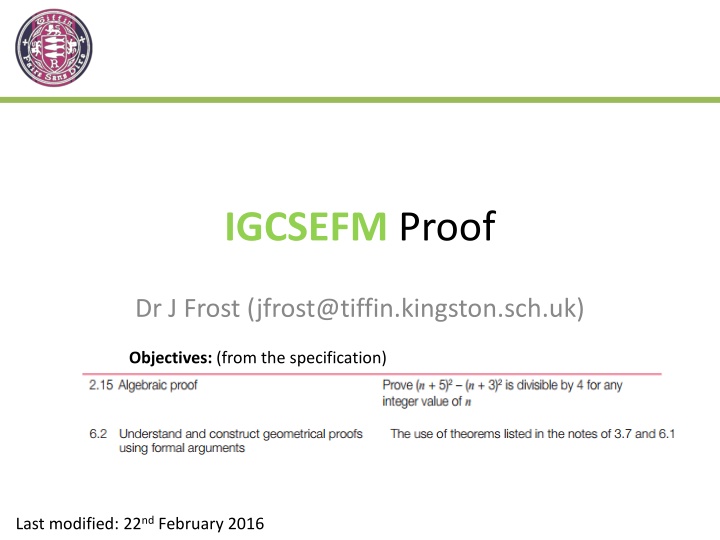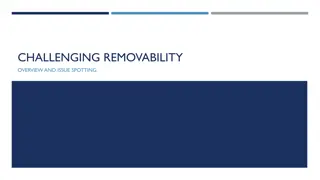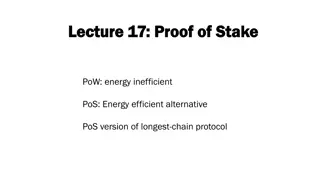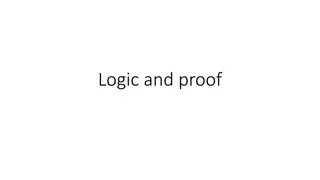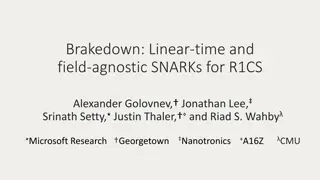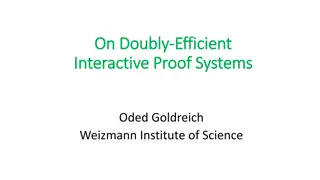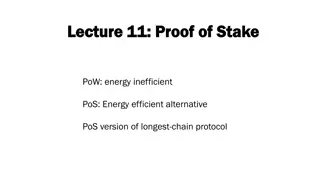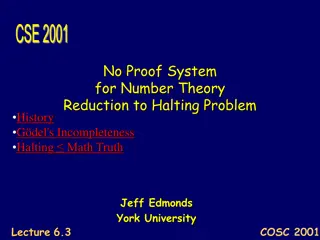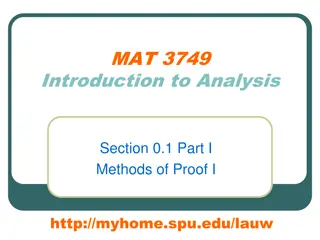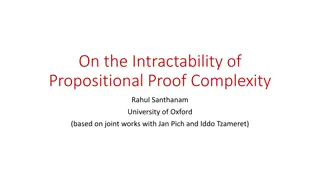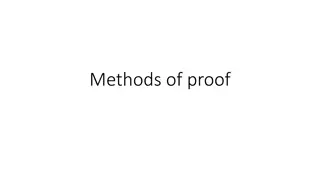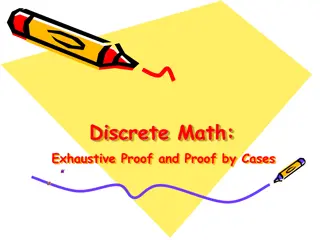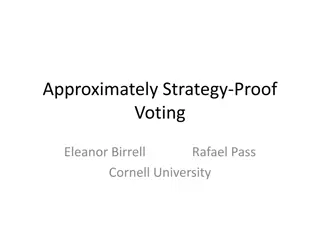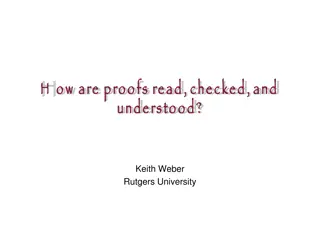Mastering IGCSEFM Proof Techniques
Dive into the world of algebraic and geometric proofs with this comprehensive guide on IGCSEFM proof techniques by Dr. J. Frost. Explore various proof examples and test your understanding with challenging questions to enhance your skills in proving mathematical statements.
Download Presentation

Please find below an Image/Link to download the presentation.
The content on the website is provided AS IS for your information and personal use only. It may not be sold, licensed, or shared on other websites without obtaining consent from the author.If you encounter any issues during the download, it is possible that the publisher has removed the file from their server.
You are allowed to download the files provided on this website for personal or commercial use, subject to the condition that they are used lawfully. All files are the property of their respective owners.
The content on the website is provided AS IS for your information and personal use only. It may not be sold, licensed, or shared on other websites without obtaining consent from the author.
E N D
Presentation Transcript
IGCSEFM Proof Dr J Frost (jfrost@tiffin.kingston.sch.uk) Objectives: (from the specification) Last modified: 22nd February 2016
Overview From GCSE, you should remember that a proof is a sequence of justified steps, sometimes used to prove a statement works in all possible cases. Algebraic Proofs Geometric Proofs Prove that the sum of three consecutive even numbers is a multiple of 6. ?? + ?? + ? + ?? + ? = ?? + ? = ?(? + ?) which is a multiple of 6. ? Prove that ? = ? Recall that the key at the end is to factorise out the 6. (We will need to recap some circle theorems)
Algebraic Proof Two common types of question: Prove that the difference between the squares of two consecutive odd numbers is a multiple of 8. Let numbers be ?? ? and ?? + ?. ?? + ?? ?? ?? = ???+ ?? + ? ??? ?? + ? = ???+ ?? + ? ???+ ?? ? = ?? which is divisible by 8. We could have also used 2? + 1 and 2? + 3. ? Prove that ?2 4? + 7 > 0 for all ?. ?? ?? + ? = ? ?? ? + ? = ? ??+ ? Since ? ?? ?, thus ? ??+ ? > ? Bro Hint: We know that anything squared is at least 0. Could we perhaps complete the square? ?
Test Your Understanding [Specimen2 Q12] ? is an integer. Prove that ? 22+ ? 8 ? is always a multiple of 4. ?? ?? + ? + ?? ?? = ?? + ? = ?(? + ?) Prove that for all values of ?, ?2 6? + 10 > 0 ?? ?? + ?? = ? ??+ ? ? ?? ? thus ? ??+ ? > ? 1 4 ? ? [Set 4 P1 Q16] Prove that, for all values of ?, 2?2 8? + 9 > 0 ? ?? ?? +? 5 [June 2013 P2 Q12] Prove that 5? + 3 ? 1 + ?(? + 2) is a multiple of 3 for all integer values of ?. = ???+ ?? ?? ? + ??+ ?? = ??? ? = ? ??? ? ? 2 ? ? ?? ? +? ? = ? ? ? ??+? = ? ? = ? ? ??+ ? [Jan 2013 P1 Q5] ? is a positive integer. (a) Write down the next odd number after 2? 1?? + ? (b) Prove that the product of two consecutive odd numbers is always one less than a multiple of 4. ?? ? ?? + ? = ??? ? ??? is a multiple of 4. ? 3 ? ?? ? therefore ? ? ??+ ? > ? ?
Identities What values of ? make the following equality hold true? ?2= 4 ?2 ? = ? ? 1 ? is 2 or -2 ? could be anything! ? ? The identity ?(?) ?(?)means that ? ? = ?(?) for all values of ?. e.g. ?2 ? ? ? 1 So ?2 4 would be wrong as it is not true when say ? is 1. When you have a quadratic/cubic/etc, all the coefficients must match to guarantee both sides of the identity are equal for all ?. [Set 4 P1 Q2] In this identity, and ? are integer constants. 4 ? 1 3 ? + = 5 ? + ? Work out the values of and ? ??? ? ?? ?? = ?? + ?? ?? ? = ? ? Comparing ? terms: Comparing constant terms: ? ?? = ?? ? = ? ? = ?
Test Your Understanding [Set 3 P1 Q2] 5 3? 2 3 ? 4(?? + 2) Work out the values of and ?. ??? ?? ?? + ?? ??? + ? ??? ?? + ?? = ??? + ? ? = ? ? Comparing ? terms: ?? = ?? Comparing constant terms: ?? + ?? = ? ? = ?
AQA Worksheet (Algebraic Proof) BONUS QUESTIONS: Prove algebraically that the sum of two consecutive odd numbers is divisible by 4. ?? ? + ?? + ? = ?? which is divisible by 4. ? Prove that the difference between two consecutive cubes is one more than a multiple of 6. ? + ?? ?? = ??+ ???+ ?? + ? ?? = ???+ ?? + ? = ?? ? + ? + ? The product of two consecutive integers is even, thus ??(? + ?) is divisible by 6. 1 3 ? [GCSE] I think of two consecutive integers. Prove that the difference of the squares of these integers is equal to the sum of the two integers. Two numbers are: ? and ? + ? Difference of squares: ? + ?? ??= ?? + ? Sum of numbers: ? + ? + ? = ?? + ? These are equal. 2 Prove that the product of four consecutive numbers is one less than a square number. ? ? + ? ? + ? ? + ? = ??+ ? ??+ ?? + ? = ??+ ???+ ????+ ?? + ? = ??+ ?? + ? 4 ? ? ?
Geometric Proof A recap of general angle theorems and Circle Theorems: ? Alternate angles are equal. Corresponding angles are equal. (Sometimes known as F angles) ? ? ? + ? = 180 ? Vertically opposite angles are equal. ? ? Cointerior angles sum to ??? .
RECAP :: Circle Theorems Angle in semicircle is 90 ? Angles in same segment are equal. Angle at centre is twice angle at circumference. ? Angle between radius and tangent is 90 . ? ? Alternate Segment Theorem. ? Opposite angles of cyclic quadrilateral are equal. ? Tangents from a point to a circle are equal in length. ?
Form of a Geometric Proof Set 1 Paper 1 Q8 Write statements in the form: ??? = ????? (??????) ??? = ? (base angles of isosceles triangle are equal) ??? = 2? (angle at centre is double angle at circumference) Angles in ??? add to 180 ? ? ? + ? + 2? = 180 4? = 180 ? = 45 ??? = 2? = 90 ?
Test Your Understanding Triangle ??? is isosceles with ?? = ??. Triangle ??? is isosceles with ?? = ??. ??? and ??? are straight lines. a) Prove that angle ??? = 2? ??? = ? (base angles of isosceles triangle are equal) ??? = ??? ?? (angles in ???? add to 180) ??? = ?? (angles on straight line add to 180) ? b) Prove that ?? is perpendicular to ??. ??? =??? ?? ? triangle are equal) ??? = ??? ?? ? ? = ?? ?? is perpendicular to ??. = ?? ? (base angles of isosceles ?
Last Step What do you think we would be the last step in your proof in each of these cases? ? Prove that ??? is a straight line. ??? + ??? = ??? therefore ??? is a straight line. ? Bro Tip: It s a good idea to finish by stating the thing you re trying to prove. ? ? ? ? Prove that the line ?? bisects ???. ??? = ??? therefore ?? bisects ???. ? ? ? ? ? Prove that triangle ??? is isosceles. ??? = ??? therefore ???? is isosceles. ? ? ?
Exercises Question 1 [Set 4 Paper 1 Q4] ??? is a right-angled triangle. Angle ??? = ?. Angle ??? = 90 2?. Prove that ??? is an isosceles triangle. ?
Question 2 ???? is a quadrilateral. Prove that ? = ?. ?
Question 3 ?? is parallel to ??. Is ?? parallel to ??? You must show your working. ?
Question 4 ???? is a cyclic quadrilateral. ?? = ??. ??? is a tangent to the circle. ? Work out the value of ?. You must show your working.
Question 5 ?, ?, ? and ? are points on the circumference of a circle such that ?? is parallel to the tangent to the circle at ?. Prove that ?? bisects angle ???. Give reasons at each stage of your working. ?
Question 6 Prove that ?? is parallel to ??. ?
Question 7 ??? is a triangle. ? is a point on ?? such that ?? = ?? = ??. Angle ??? = ?. a) Prove that angle ??? = 2?. b) You are also given that ?? = ??. Work out the value of ?. ?
